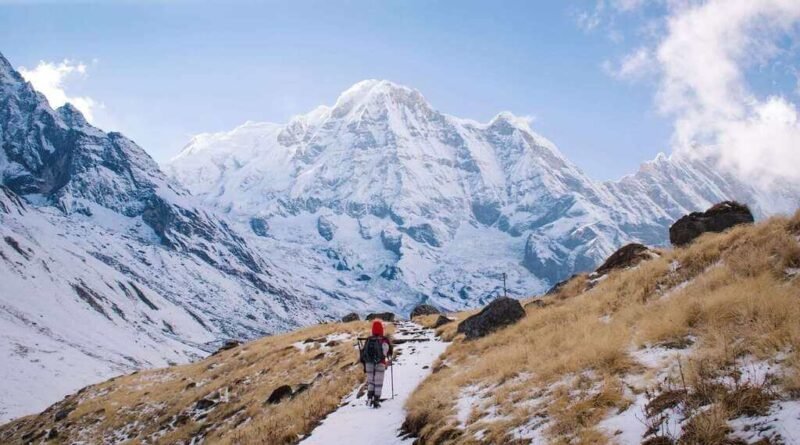Essential items to pack for Annapurna Base Camp trek
To ensure a smooth and enjoyable trek to Annapurna Base Camp, it’s crucial to pack wisely and avoid unnecessary items.
Since you’ll be responsible for carrying your belongings along with your porter, it’s advisable not to go overboard with packing.
You don’t need a new set of clothes for each day; reusing items like socks, leggings, t-shirts, and underpants is perfectly fine.
To assist you in preparing for your journey, we’ve compiled a comprehensive list of essential items for the Annapurna Base Camp trek.
This packing guide is also applicable for other Himalayan trails like the Everest Base Camp trek, Manaslu Circuit trek, Everest High Passes trek, and more.
One common mistake that many trekkers make is over-packing, which can make the trek more challenging. The key is to pack light and smart.
Embarking on the Annapurna Base Camp hike promises an unforgettable experience amidst diverse landscapes and breathtaking Himalayan vistas.
To optimize your adventure, packing intelligently is crucial. Here’s a brief overview of the essential items you should have in your backpack.
Table of Contents
Travel Clothing:
Leggings or Hiking Pants:
During the Annapurna Base Camp trek, comfortable and flexible lower body attire is essential. Leggings or hiking pants provide ease of movement and protection from the elements. They are designed to withstand challenging terrain while ensuring comfort throughout the journey.
Sunglasses:
Sunglasses are essential for eye protection against the intense mountain sunlight. The glare from snow-covered landscapes can be harsh, and wearing sunglasses helps prevent eye strain and potential damage from UV rays.
Sports Bra (for women):
Supportive sports bra is vital for female trekkers, providing comfort and reducing the risk of discomfort or injury during the trek. It ensures proper support during physical activity, especially on uneven terrains.
Down Jacket:
An insulated down jacket is crucial for staying warm at higher altitudes where temperatures can drop significantly. Its lightweight and compressible nature makes it easy to carry in your backpack, providing effective insulation when needed.
Warm Knit Cap/Hat (Fleece or Woolen):
As a significant portion of body heat is lost through the head, a warm knit cap or hat is essential for maintaining body temperature. It protects against cold winds and low temperatures, especially during chilly evenings and nights.
Gloves:
Gloves are necessary to protect your hands from the cold, particularly at higher altitudes. They also provide a good grip while navigating through varied terrains and ensure your hands stay warm during the trek.
Wide-Brimmed Cap/Sun Cap:
A wide-brimmed cap or sun cap is essential to shield your face and neck from the intense mountain sun. It helps prevent sunburn and provides much-needed shade during sunny days on the trail.
Waterproof Pants:
Waterproof pants are crucial for trekking in unpredictable mountain weather. They protect against rain and snow, keeping you dry and comfortable. This is particularly important during sudden weather changes.
Underwear:
Comfortable underwear is essential for preventing chafing and ensuring overall comfort during the trek. Choose breathable materials that dry quickly.
Long-Sleeved Thermal Tops:
Thermal tops provide an extra layer of warmth, especially during colder days or at higher altitudes. They are designed to trap and retain body heat, keeping you comfortable in varying weather conditions.
Comfortable Pants:
Comfortable pants are essential for ease of movement during the trek. Choose lightweight, quick-drying materials that provide comfort and flexibility on the trail.
Fleece Buff/Neck Warmer/Neck Gaiter:
A fleece buff or neck gaiter serves as a versatile accessory, providing warmth to the neck and face. It can be adjusted to different styles for varying temperatures and conditions, offering both comfort and protection.
Wind/Waterproof Jacket:
A wind and waterproof jacket is crucial for protection against the elements. It acts as a barrier against strong winds and sudden rain, ensuring you stay dry and comfortable throughout the trek.
Footwear:
Good quality boots:
Invest in high-quality, water-resistant hiking boots with ankle support, as the trek involves varied terrain, including uphill and downhill climbs, as well as numerous stairs. Properly breaking in your boots is crucial to ensure comfort and prevent discomfort or blisters during the trek.
Socks:
Proper socks are crucial to prevent blisters and ensure foot comfort during long walks. Quality hiking socks with moisture-wicking properties help keep feet dry, reducing the risk of discomfort and potential foot issues.
Non-trekking shoes/ running shoes:
Non-trekking or running shoes are essential as they provide comfort during downtime in teahouses and a practical, lighter option for various activities beyond trekking.
Trekking equipment, Gears and Accessories:
Trekking equipment, gears, and accessories are indispensable for the Annapurna Base Camp trek, ensuring your safety, comfort, and overall success in traversing challenging terrains.
Properly chosen and well-maintained equipment, such as trekking poles, a reliable backpack, and weather-appropriate clothing, provide stability and ease during the trek.
Additionally, essential accessories like a headlamp, first aid kit, and navigation tools contribute to preparedness in the unpredictable mountain environment.
These items collectively enhance your overall trekking experience by addressing various challenges and adapting to the diverse conditions encountered along the Annapurna Base Camp trail.
- Sleeping bag
- Umbrella
- Trekking backpack
- Garbage bag
- Sleep sheet / Sleeping bag liner
- Light weight quick dry towel
- Cash
- Battery pack/ portable power bank
- Reusable Water bottle
- Water purification tablets
- Trekking poles
- Head torch
Medical/first-aid kit
- Antibiotics
- Painkillers
- Cough Lozenges
- Plasters, Bandages
- Antidiarrheals
- Altitude sickness drugs
- Oral Rehydration Sachets
- Eye drops
- Ear plugs
- Prescriptions
- Sunscreen cream
- Lip Balm
- Insect repellent
- Hand sanitizer
- Biodegradable Wet Wipes/Baby Wipes
- High-calorie snacks (optional)
- Electrolytes, powder or tablets (optional)
Toiletries
- Toothbrush
- Toothpaste
- Personal First Aid Kit
- Small bar or soap bottle
- Dry Shampoo
- Quick-drying towel
- Multi-purpose soap
- Deodorants
- Nail Brush & Clippers
- Hair Brush
- Face Flannel
- Hand and face moisturizing cream
- Toilet Paper
Each item listed here serves a specific purpose in ensuring your comfort, safety, and overall well-being during the Annapurna Base Camp trek.
It’s crucial to prioritize high-quality materials and functionality to optimize your experience in the challenging Himalayan environment.
Fortunately, trekking gear and clothing are readily available in Nepalese markets.
For those on a budget, renting trekking essentials like backpacks, poles, and even down jackets is a viable option.
Armed with these essentials, you’ll be well-equipped to conquer the Annapurna Base Camp trek and create lasting memories in the Himalayas!
Remember, this serves as a starting point, and you may need to adjust your packing list based on the specific time of year and your personal preferences.
Also Read:
12 Popular Make up Artist Beauty Travel Blogger Dubai
Top Foods You Should Try in Dubai




